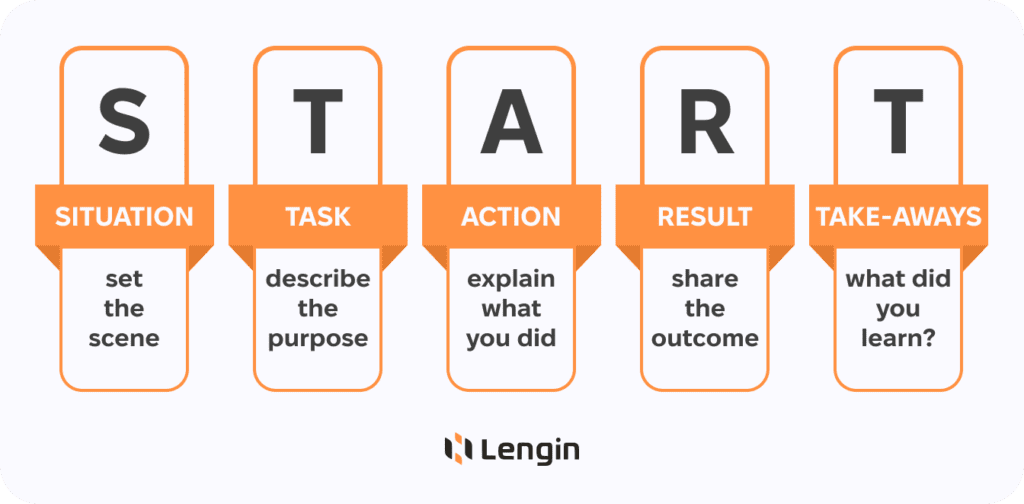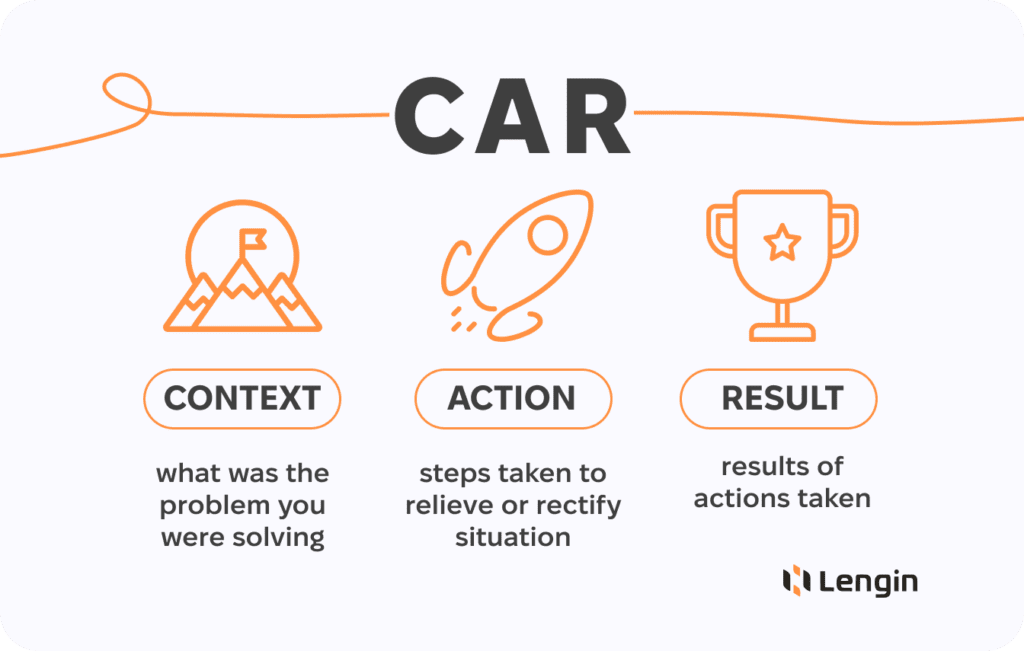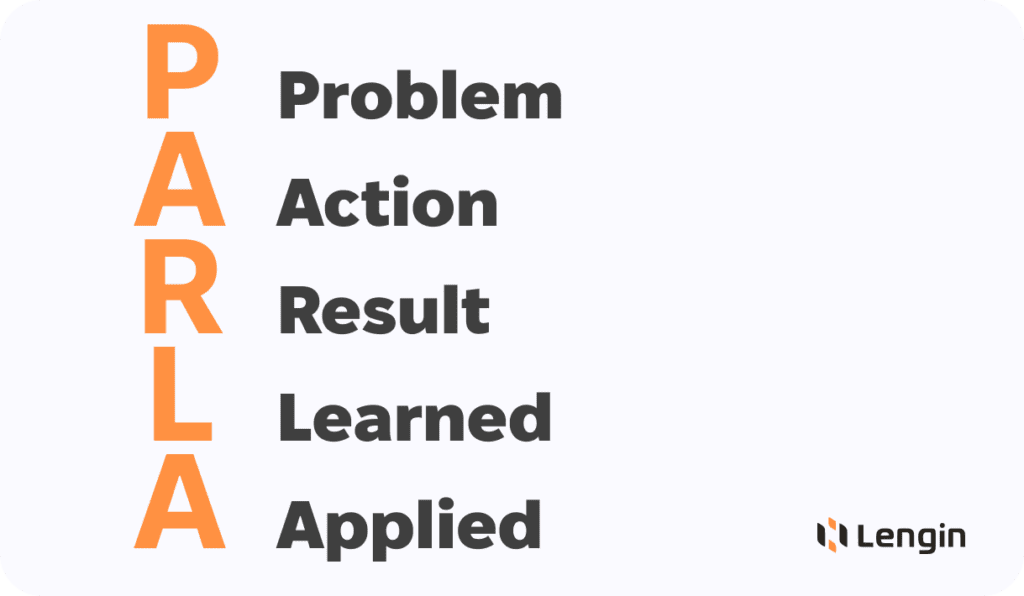Behavioral interviews aim to assess soft skills through real examples from a candidate’s background.
It demands a lot of preparation, experience, and discernment. Different interview methods make this process more structured.
Choosing the right framework depends on your needs and allows for a natural two-way discussion. Let’s explore the frameworks that have already proved their effectiveness.
Table of Contents:
STAR Method And Its Evolution Into START

STAR is not the only practical framework that you can use to check the candidate’s experience. HR teams and candidates have been using this method for years, so it’s evolved into START.
- S – situation. Understanding the context and seeing the big picture is essential to correctly interpreting and evaluating the actions’ effectiveness.
Initiate the discussion by asking, “Can you describe a time when you had to deal with a difficult colleague or team member?”
If the candidate didn’t go into specifics and you’d like to learn more, ask, “What was your role at the time, and who else was involved?” to further unfold the story.
- T – task. The task can be interpreted as a current objective, obstacle, or challenge.
This step is often skipped in the natural conversation, so you can come back and ask, “What specific goal or outcome did you need to achieve in that situation?”
- A – action. Here, the candidate reveals the step-by-step plan for resolving the issue.
- R – results to show the effectiveness of made decisions.
- T – takeaways. This one checks how candidates can learn from their mistakes and draw conclusions. Ask what this experience brought them.
However, not only is the START method efficient but CAR and PARLA are good options, too. Also, those two frameworks are less popular among the candidates, so they might be less prepared for them.
CAR Behavioral Interview Method

CAR stands for Context, Action, and Result.
Context includes the description of the situation and the task from the STAR method. It might bring a general understanding of what was happening without excessive details. The CAR interview method is more optimized and less time-consuming.
PARLA Behavioral Interview Method
PARLA is another framework that has great potential.

- P – problem. Challenges, obstacles, conflicts, force-majors, etc.
- A – action. Key things that have been done.
- R – result.
- L – learned. This is similar to takeaways in the START framework.
- A – applied. This point is the most important and makes this interviewing method stand out.
The crux of PARLA lies here – how the learning was implemented in the subsequent decisions. Here, it would be best if you asked how something the candidate took from this experience influenced their decisions in the future.
How learned knowledge was applied reveals critical thinking skills and self-awareness and shows the level of self-reflection.
Behavioral Interview Questions For Each Method
To reveal the specifics of the situation and general context, ask, “What additional details can you provide to set the scene?” or “What were the key players and factors involved?”
To understand the problem, ask, “What was the main obstacle to achieving the objectives?” and “Why did you consider this situation problematic?” to understand how the candidate estimated possible outcomes of leaving the issues unattended.
The task can be clarified with questions like “What was the specific objective or goal that needed to be accomplished?” and “What were your responsibilities related to this task?”
When you come to the point of discussing actions, ask additional questions to understand the logic better:
- What specific steps did you take to address the situation?
- What alternatives did you consider and why?
- What was your individual role and contribution?
- How did you prioritize the various tasks that needed to be done?
- How did you know your actions were moving the situation in the right direction?
Talking about the result, ask, “How did you measure the success or impact of your approach?” “What feedback, if any, did you receive from stakeholders on your actions?” or “Did any unintended positive or negative results also occur?”
Each challenge brings experience, and you want to ensure that a lesson is learned. That’s why use the following questions:
- What aspects of the situation surprised you the most in hindsight?
- How has your understanding of your own strengths/weaknesses evolved?
- What advice would you share with a colleague in a similar situation?
- What would you have done differently with the benefit of hindsight?
Last but not least the applied section from the PARLA behavioral interview method.
Ask questions like: “How will this lesson influence your approach going forward?” and “What actions did you take differently due to gained knowledge from this experience?”
This way, you can explore all the peculiarities of the candidate’s experience, but don’t go too far. Excessive questions can be exhaustive and make the candidate feel like you don’t trust the information they give.
Which Method For A Behavioral Interview Should You Choose?
The most effective method is the one the interviewer feels comfortable with and can have a natural conversation around.
The CAR interview method is the least time-consuming, so it is the perfect variant for initial screening when time is limited, and you want to cover the most critical aspects of the candidate’s experience.
START is better used for more profound interviews. STAR method, or its newer version, START, is aimed at a more detailed analysis of the candidate’s background. It takes not only more time but also a lot of cognitive resources for both the interviewer to analyze the answer and the interviewee to answer all the questions.
Of all behavioral frameworks, PARLA best facilitates the assessment of a candidate’s critical thinking evolution, learning agility, and ability to transfer insights into meaningful actions. That’s why PARLA is usually used to interview candidates for senior management positions.
If there are any doubts about which behavioral interview method is suitable, try to mix them. Combining methods, like starting with CAR and then following up with a RARLA question, can maximize the benefits of each approach.